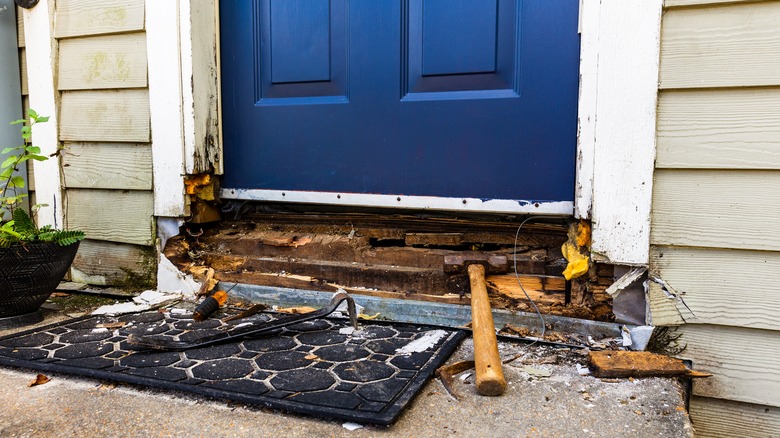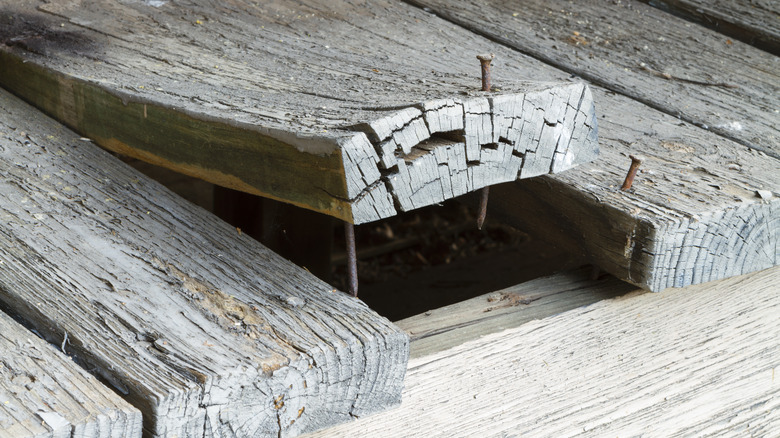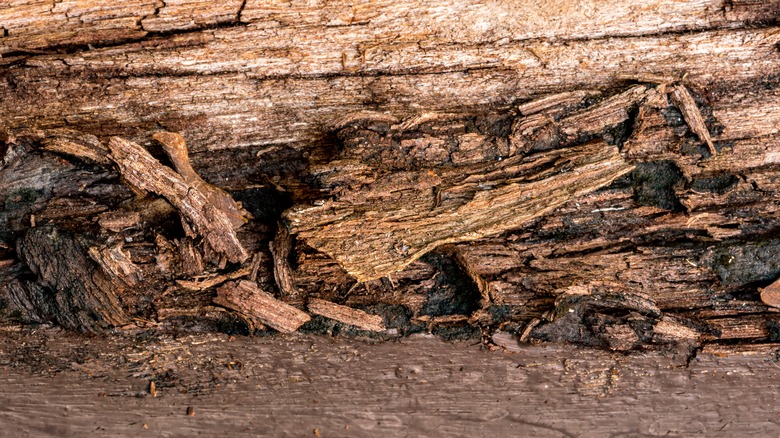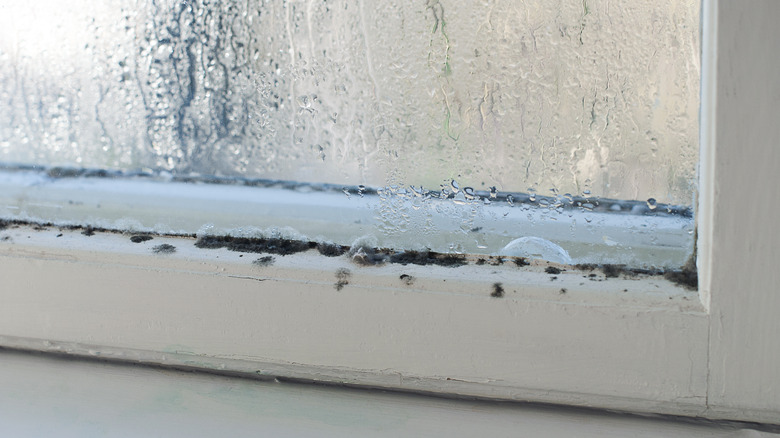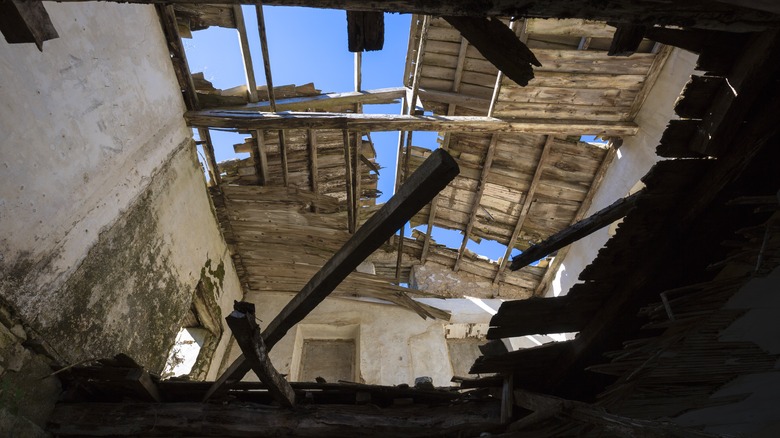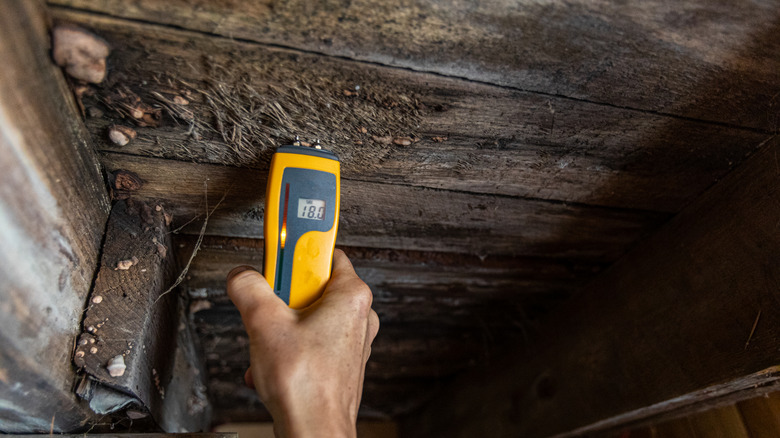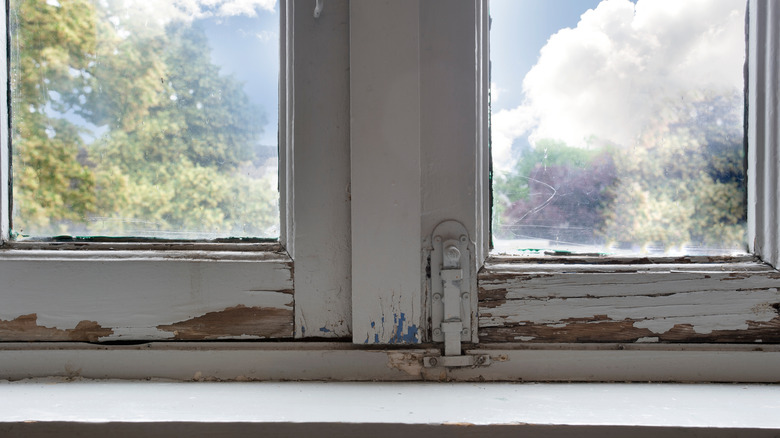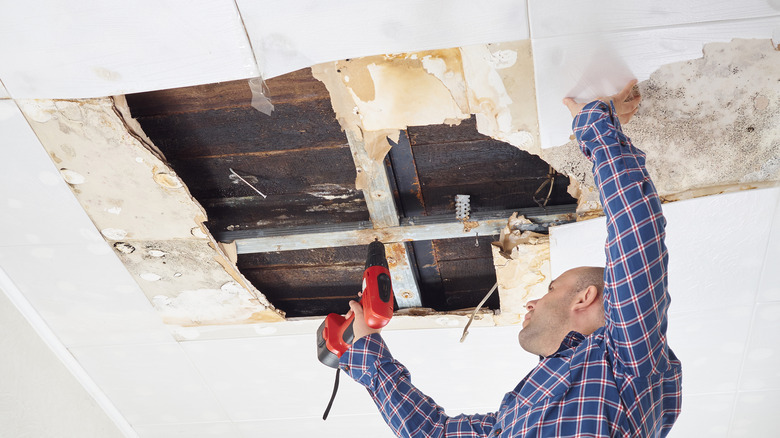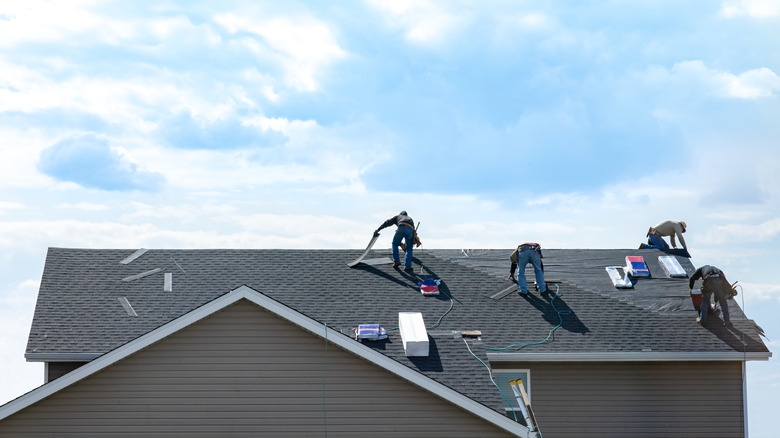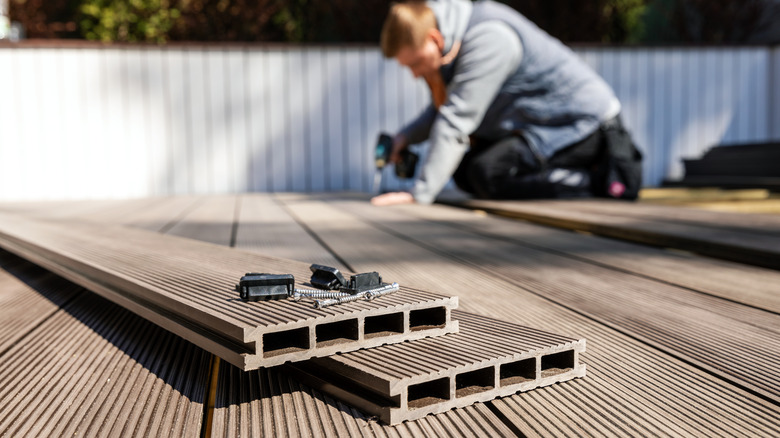Tips On How To Identify, Fix, And Prevent Wood Rot
Wood rot is precisely what it sounds like: rotted wood. Sleeping Dog Properties explains that you can think of wood as a large box of straws. Cutting the wood is the equivalent of opening the box of straws: The wood will absorb water, spreading the water throughout the piece of wood. If too much water is absorbed by the wood, it can cause it to rot. Without proper treatments and actions, the wood rot has the potential to spread. This can lead to various issues, ranging from more minor cosmetic eyesores to those that threaten the structural integrity of a building.
Learning more about the causes and different types of wood rot, and how to identify it, can save you from a lot of headaches — and even potentially hazardous situations. Continue reading to learn these key characteristics to look out for, along with some tips for fixing and preventing wood rot in the future.
What causes wood rot?
As Wood Finishes Direct explains, wood rot isn't always caused by the same thing. However, all of the potential causes have one thing in common: water. You cannot have wood rot if the wood is dry and has never gotten wet. Water is always a factor.
While there can be different causes for wood rot, there are a few that are more common than others. One common cause is when the wood from a structure is in direct contact with the soil beneath it. When wood is at the base of a structure, it is important to make sure that there is a minimum of 6 inches of clearance to make sure the wood doesn't wick up moisture from the soil.
Sprinklers and drain pipes may also cause wood rot. If these fixtures aren't properly placed and are too close to decks, sheds, or other wood features, they can keep them too wet, eventually leading to rot. Other potential causes for wood rot include plumbing issues, damaged roofing, pooling water at the base of a structure, and poor maintenance of decking and other wooden elements.
Brown rot vs. white rot vs. soft rot
There are three common types of wood rot. Major Painting explains that with each type of wood rot, moisture in the wood causes the wood to decay. This then causes a fungus to grow. While each type of wood rot has its own set of characteristics, they all can pose a serious threat.
One of the most common types is brown rot. You may have heard this type referred to as dry rot before. However, because brown rot is really caused by moisture, dry rot isn't the most accurate term for it. With brown rot, the wood's cellulose is broken down by a fungus after the wood has been exposed to too much moisture. This then causes cracks to form in the wood. Wood affected by brown rot will have a very dry and cracked appearance.
White rot is another type you may encounter. The cellulose in wood is also damaged by the fungus that causes white rot. However, one key way white rot differs from brown rot is that it causes the wood to feel spongy. Affected wood may also have some white markings on it. Out of the three main types of wood rot, white rot can cause the most damage in the shortest amount of time. The fungus causes the wood to decompose quickly, which can pose a major safety hazard.
While not as common as brown or white rot, soft rot can also pose a threat. You're most likely to find soft rot in a location that doesn't offer the ideal conditions for white or brown rot to form, such as a place where there is too much moisture or the temperature is too warm or too cold. Soft rot doesn't spread as quickly as white or brown rot either.
Is wood rot the same as mold?
Now that you've learned a little bit about wood rot, you may be wondering whether it is the same as mold. After all, moisture is a common cause for both wood rot and mold. However, they are not the same thing. Indiana Foundation Service explains some of the key differences between wood rot and mold that can help you determine which moisture-related concern you're dealing with. Though both are caused by fungi, the specific species responsible for each type of damage is different.
Mold may be toxic to humans, depending on the specific fungi species responsible for the outbreak. Mold can be many different colors, including black, green, orange, white, and purple. It can also have a slimy appearance. Mold spores are released into the air, which allows the mold to reproduce and spread. You can test for mold in your house, but because of its potential toxicity, it may be best to contact a professional. Wood rot is different from mold because of the detrimental impact it can have on the wooden structure. As it spreads, it actually digests the wood. This can make the wood less stable and a potential safety hazard.
These differences between wood rot and mold can help you determine which one is threatening your home. If you notice more discoloration, chances are that you're dealing with mold. If what you're looking at appears to be decaying, it is most likely wood rot. However, because both problems are caused by moisture, it is possible to be dealing with both wood rot and mold, or possible that noticing one now may mean you'll soon be dealing with the other if the underlying causes aren't addressed.
Problems that wood rot can cause
While wood rot certainly doesn't look attractive, it can be more serious than just being an eyesore on a property. All American Painting Plus explains that individuals should act quickly to address wood rot to avoid potential problems. As they detail, these problems may range from safety concerns for the property to health concerns for the individuals living in it.
The largest safety concern posed by wood rot is structural weakness of the property. Wood is commonly used during construction projects to provide a stable foundation or offer support features. However, if these features of a home or structure are exposed to moisture and start rotting, the wood will begin to lose its strength and durability. This could cause it to break down, leading to severe consequences for the overall structure, or injuries for anyone around if something gives or collapses. Wood rot can also make a home or building more susceptible to pests. As the wood rots, mice, insects, and other pests will be able to find more gaps and openings, allowing them to enter your home. Beyond the annoyance of dealing with a rodent or insect infestation, pests can also carry diseases, which can threaten the health of the people in the home.
How to identify wood rot
Performing an annual inspection of the wood structures in your home — or hiring a professional to complete the inspection — can help you detect rotting wood and address it before it becomes a major hazard. My Handyman shares some tips to help you look for wood rot. You'll just need a flashlight and a screwdriver to conduct the inspection.
Begin by thinking about the different areas of your home where there is exposed wood. Some examples include decking, crawlspaces, attics, or unfinished areas in the basement or laundry room. Visit these places and shine your flashlight at each section of exposed wood. Look for any signs of wood rot, including chipping or cracked wood, texture changes, discoloration, sections that are missing or broken-off, or fungal growth. You can also identify wood rot by using a screwdriver. Hold the screwdriver up against the piece of wood in question and apply a little pressure. If the screwdriver pushes into the wood easily and the wood doesn't give much or any resistance, then you can safely assume there is wood rot.
Where wood rot is most likely to occur
According to How To Look At A House, some areas of the home are more likely to rot than others. As they point out, it's more common to discover wood rot in areas of the home that are closer to the ground. This is because these areas are often sitting in or near water, compared to the parts of the structure that are higher off the ground.
Water traps — or parts of the structure that are either flat or slope towards the home — can also be a common place to find wood rot. The surfaces, such as window sills or the overhang above a window, can hold water, rather than letting it run off. Because of this, they can stay wet for longer, leaving the wood exposed to more water and causing it to rot. The inside corners of a structure may also be more likely to rot than other sections. This is because the water may collect here as it comes off the roof. A few of the other common areas where wood rot may occur include places where caulking is missing or is beginning to deteriorate, behind downspouts and gutters, and along wood with peeling paint.
How to fix wood rot
CNC Masters explains that the degree of damage will impact whether wood rot needs to be repaired or replaced. Therefore, the first step is to assess the damage and determine whether replacement or repair is the best course of action. Rotted wood will need to be replaced if the damage is severe enough that the stability of the wood is compromised. Some signs that indicate severe enough damage to warrant replacing the wood include very deep cracks going across the wood's grain, growth along the wood that look like mushrooms, and fibers that are white in color.
If the degree of damage is not so severe that the wood needs to be replaced, you may be able to repair the rotted wood. To fix wood rot, you will first need to remove rotted sections from the board to prevent further spread of the rot. Then, use a wood patch or wood polyester fill to patch up the sections where the rot was removed. Such patches can help maintain the structural integrity of a wood board or joist.
The cost to fix wood rot can vary
If you plan on hiring a professional to fix areas of wood rot, the cost can vary based on the location and extent of the damage. According to CostOwl, basic wood rot repair jobs performed by a professional may cost as little as $100. Repairing damaged siding may cost up to $2,500, though most jobs generally cost closer to $1,000. However, you can expect the cost of wood rot repair to increase rather substantially for larger jobs. As an example, if an entire porch requires replacement due to wood rot, it typically costs between $7,500 and $50,000. Other jobs, such as replacing floor joists, can cost between $4,000 and $12,000.
While larger repair jobs are likely best left to a professional, you may be able to tackle minor repairs yourself. In this case, you can expect to spend between $50 and $150 for epoxy to fill in a small section of damaged wood. However, this type of repair is likely to only offer a short-term solution, rather than a more permanent one.
How to prevent wood rot
Croft Preservation shares a few steps that you can take to reduce the chances that parts of your structure become damaged by wood rot in the future. They recommend using caulk to seal gaps along your windows and doors. Before applying new caulk, be sure to remove any old caulking that is still present so that it doesn't negatively impact the seal of the new caulk. Catching and fixing roof damage quickly is also important for preventing wood rot. If you can stop water from entering into your home, it won't have the opportunity to cause any damage. Likewise, keeping your gutters cleaned and repairing leaky sections will also protect your structure and ensure that water doesn't pool up in the gutters or around the property.
Addressing moisture issues within the home is another main thing you can do. Some rooms in the home — such as the kitchen, bathroom, and basement — tend to be more humid than others. Using dehumidifiers in these rooms can help reduce the humidity level and keep wood from becoming damp. Similarly, it is a good idea to install and run extractor fans in the bathroom during and after showers, as well as above the stove in the kitchen to pull steam and humidity from the air.
When you're building something new out of wood, there are also a few extra measures you can take during the construction process to prevent, or significantly decrease, the chances of wood rot. Scott Sidler from The Craftsman Blog shares some of his favorite tips for preventing wood rot. He recommends using an oil-based primer to prime all six sides of wooden boards, not just the edges that will be visible in the finished product. When applying primer, two coats are even better than one to add an additional layer of protection. Another tip he shares is to avoid using completely horizontal surfaces when building. Flat surfaces will provide a place for water to sit on the wood, which can lead to wood rot. Rather, consider the design of each project before you start building and work in sloped surfaces or rounded elements to eliminate the opportunity for water to sit and soak into the wood.
Using plug fasteners over nails or screws will cover up divots where water may be able to enter the wood. Plug fasteners will also help keep your hardware from rusting if it gets wet. Finally, you can also look for a more rot-resistant wood when planning an outdoor project. Some examples include western red cedar, teak, or camaru. If you're thinking about installing a new deck or working on another outdoor project, consider using an alternative material — such as composite decking, concrete, or aluminum — that won't rot like wood does.
Consider wood alternatives for exterior projects
If you're thinking about installing a new deck or working on another outdoor project, you can also consider using a wood alternative to remove the threat of wood rot. Worst Room Home Design highlights several decking alternatives that may be the right fit for your job. Not only do these wood alternatives not rot, but they may also cost less than a wood deck.
One wood alternative to consider is concrete. Pattern-imprinted concrete decking can mimic the look of wood, but it is also more durable and less expensive than real wood. Concrete decking also doesn't discolor or splinter like real wood does. Aluminum decking can also eliminate the threat of wood rot. With aluminum decking, you also won't have to worry about mold, termites, or rust. Other benefits of aluminum decking include its low cost and the fact that it is very lightweight, easy to install, and low maintenance. However, there are a few downsides of aluminum decking to consider. You won't be able to mimic that real wood look with aluminum, like you can with some other alternatives. Rain hitting aluminum decking will also be much louder than it would sound when hitting wood or other materials.
Composite decking has become a popular option for many consumers. Made from recycled plastics and wood fibers, it is not only rot-resistant, but also pest-, slip-, and UV-resistant. Composite decking is very durable and long-lasting. It is also available in a wide array of colors to help you get the exact look you desire. However, unlike some other wood alternatives, installing composite decking will cost more than a real wood deck.
